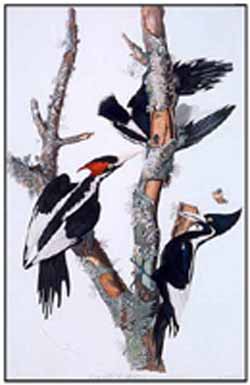Independent researchers confirm the existence of ivory-billed woodpecker

Ivory-billed Woodpecker from Audubon Plate 66
After reviewing new sound recordings from the White River of Arkansas, an independent team of ornithologists has confirmed the existence of the Ivory-billed Woodpecker.
Working from previously unpublished data provided to them in the last few days by John Fitzpatrick and colleagues at Cornell University, ornithologists at Yale, the University of Kansas, and Florida Gulf Coast University have concluded that the bird has been indeed been detected for the first time in decades.
Yale ornithologist Richard Prum states, “We were very skeptical of the first published reports, and thought that the previous data were not sufficient to support this startling conclusion. But the thrilling new sound recordings provide clear and convincing evidence that the Ivory-billed Woodpecker is not extinct.”
The unpublished recordings include a series of distinctive “kent” call notes and an exchange of the diagnostic “double raps” between two individuals. According to Mark Robbins of the University of Kansas, “The recordings of the double raps sound very natural, and are totally consistent with the behavior or the Central and South American relatives of the Ivory-billed Woodpecker.”
These recordings provide the first evidence of the existence of more than one individual Ivory-bill. Cornell researchers plan to release the recordings at a meeting of the American Ornithologists’ Union in Santa Barbara, California at the end of the month.
Prum and colleagues had prepared a manuscript critical of the original reports to the journal PLoS Biology. In that manuscript which is withdrawn, the authors concluded that definitive evidence was still necessary and wrote, “We sincerely hope that this evidence is forthcoming soon.”
Now it is. Prum and Robbins are delighted.
Media Contact
More Information:
http://www.yale.eduAll latest news from the category: Ecology, The Environment and Conservation
This complex theme deals primarily with interactions between organisms and the environmental factors that impact them, but to a greater extent between individual inanimate environmental factors.
innovations-report offers informative reports and articles on topics such as climate protection, landscape conservation, ecological systems, wildlife and nature parks and ecosystem efficiency and balance.
Newest articles

A universal framework for spatial biology
SpatialData is a freely accessible tool to unify and integrate data from different omics technologies accounting for spatial information, which can provide holistic insights into health and disease. Biological processes…

How complex biological processes arise
A $20 million grant from the U.S. National Science Foundation (NSF) will support the establishment and operation of the National Synthesis Center for Emergence in the Molecular and Cellular Sciences (NCEMS) at…

Airborne single-photon lidar system achieves high-resolution 3D imaging
Compact, low-power system opens doors for photon-efficient drone and satellite-based environmental monitoring and mapping. Researchers have developed a compact and lightweight single-photon airborne lidar system that can acquire high-resolution 3D…





















